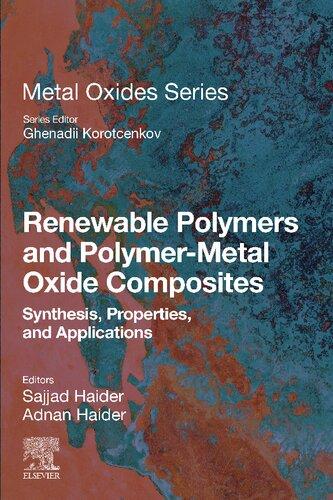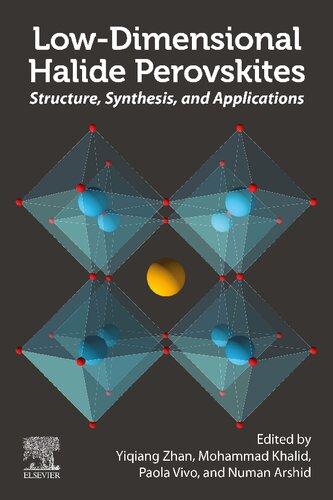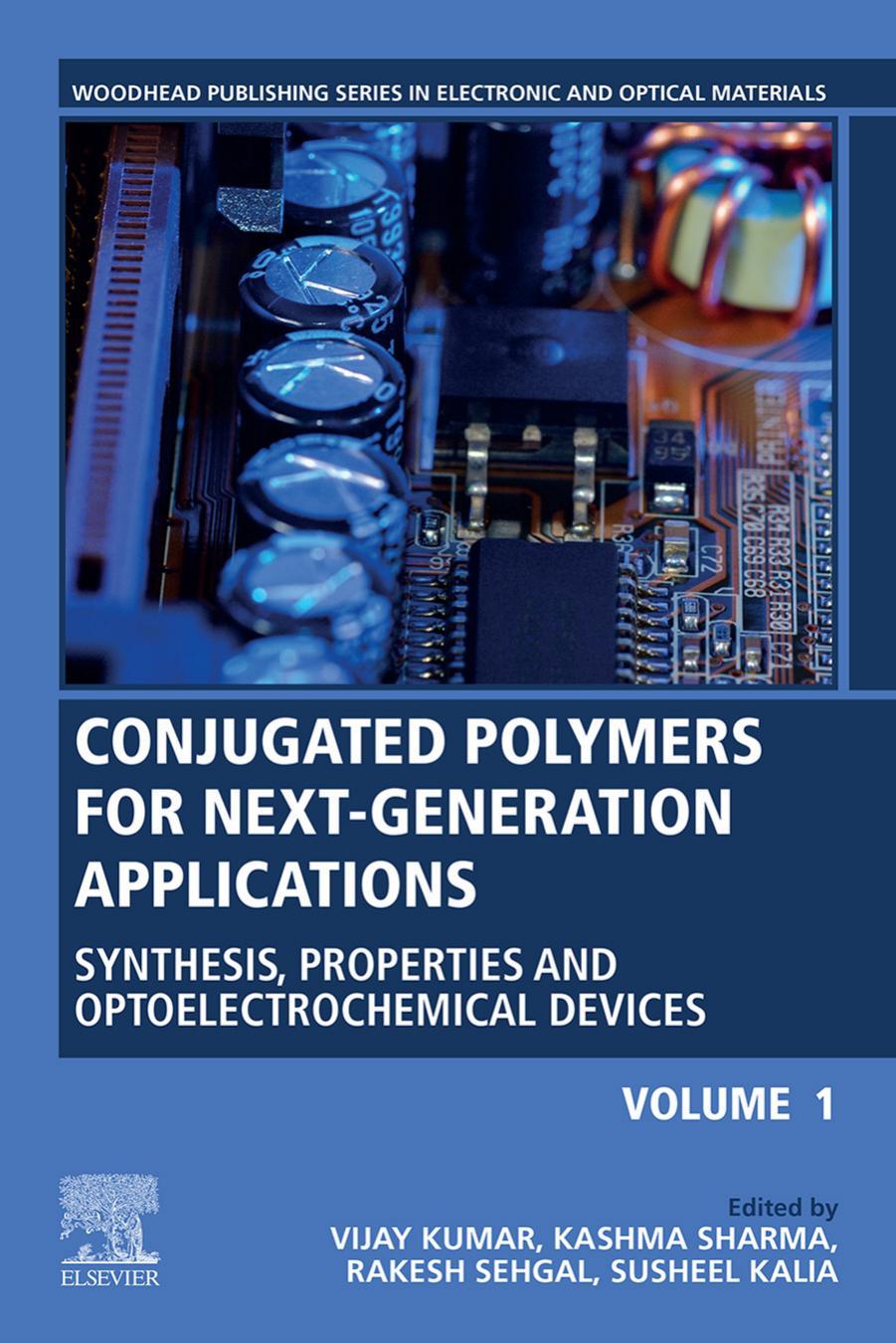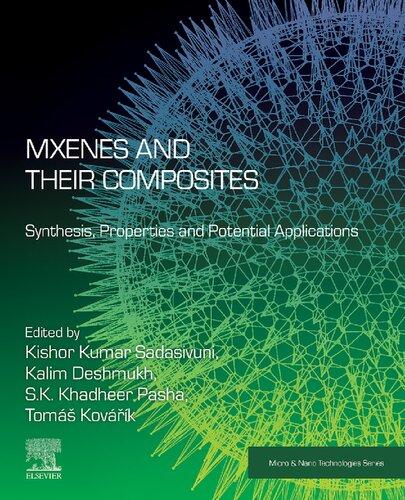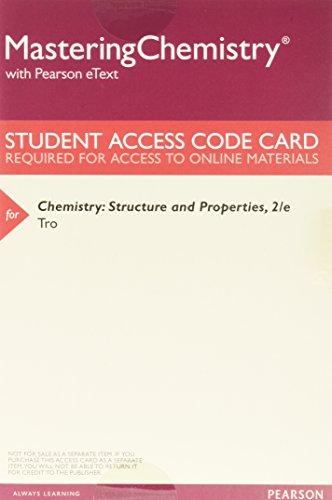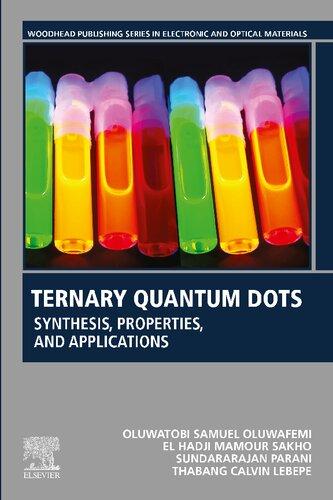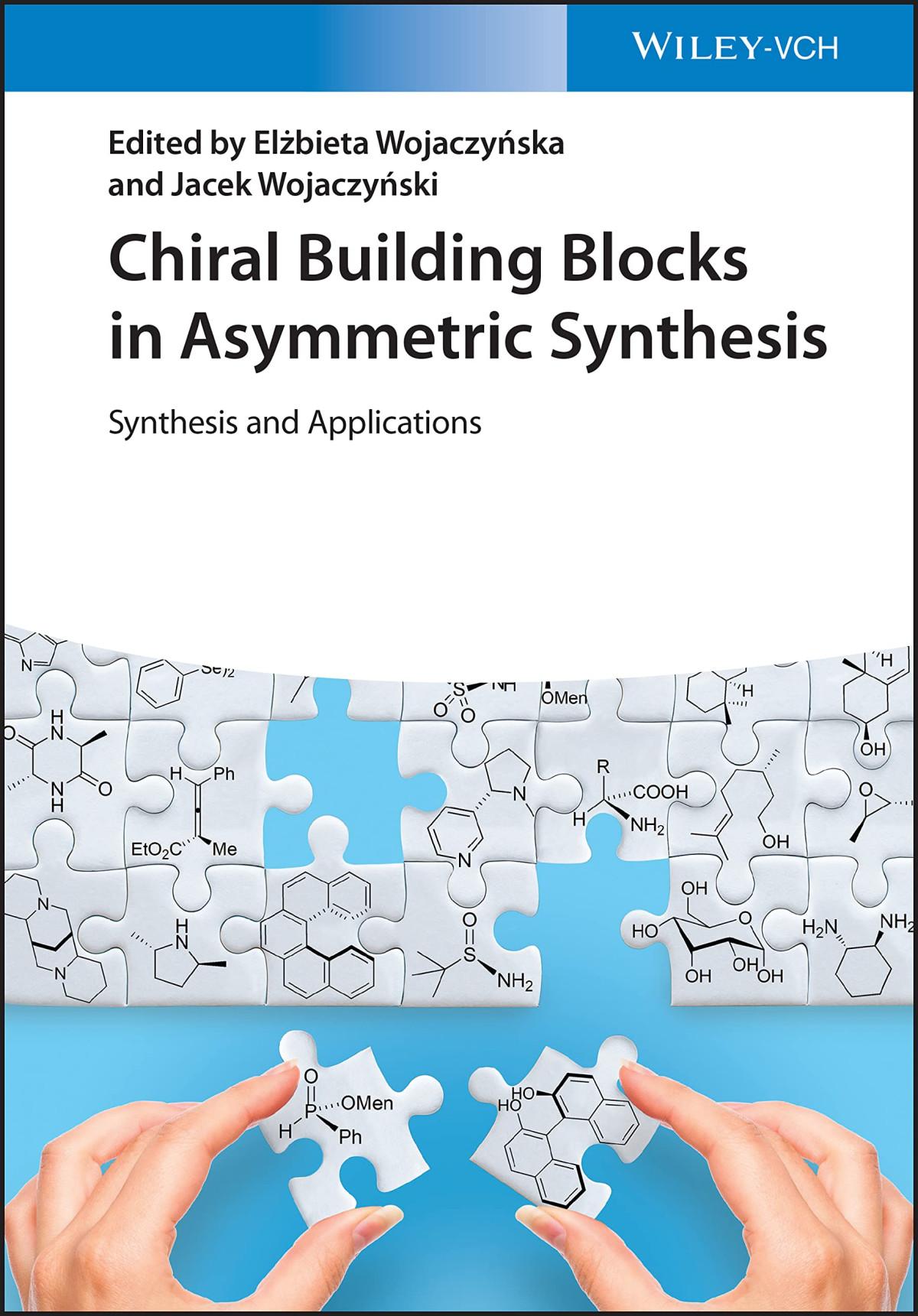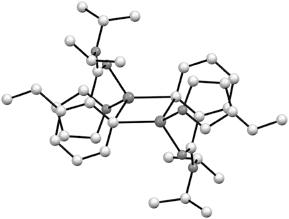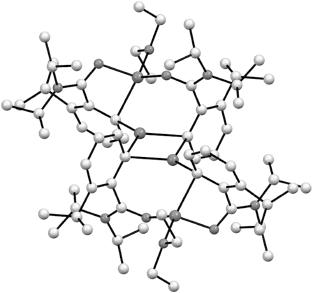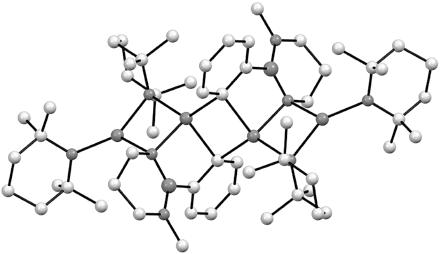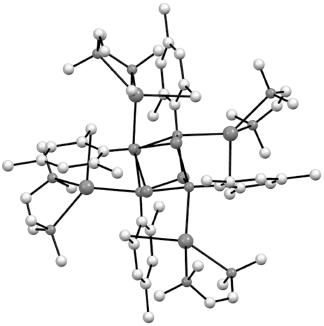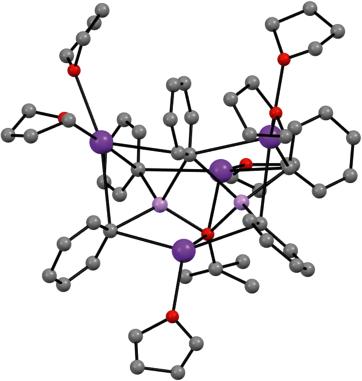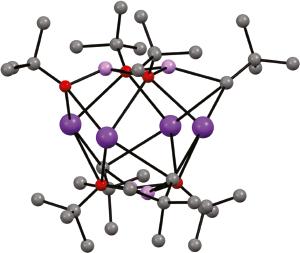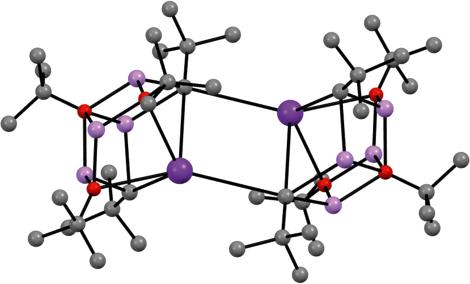Polar Organometallic Reagents
Synthesis, Structure, Properties and Applications
Edited by Andrew E. H. Wheatley
University of Cambridge Cambridge, UK
Masanobu Uchiyama
The University of Tokyo Tokyo, Japan
This edition first published 2022
© 2022 John Wiley & Sons Ltd
All rights reserved. No part of this publication may be reproduced, stored in a retrieval system, or transmitted, in any form or by any means, electronic, mechanical, photocopying, recording or otherwise, except as permitted by law. Advice on how to obtain permission to reuse material from this title is available at http://www.wiley.com/go/permissions.
The right of Andrew E. H. Wheatley and Masanobu Uchiyama to be identified as author(s) of the editorial material in this work has been asserted in accordance with law.
Registered Office(s)
John Wiley & Sons, Inc., 111 River Street, Hoboken, NJ 07030, USA
John Wiley & Sons Ltd, The Atrium, Southern Gate, Chichester, West Sussex, PO19 8SQ, UK
Editorial Office
The Atrium, Southern Gate, Chichester, West Sussex, PO19 8SQ, UK
For details of our global editorial offices, customer services, and more information about Wiley products visit us at www.wiley.com.
Wiley also publishes its books in a variety of electronic formats and by print-on-demand. Some content that appears in standard print versions of this book may not be available in other formats.
Limit of Liability/Disclaimer of Warranty
In view of ongoing research, equipment modifications, changes in governmental regulations, and the constant flow of information relating to the use of experimental reagents, equipment, and devices, the reader is urged to review and evaluate the information provided in the package insert or instructions for each chemical, piece of equipment, reagent, or device for, among other things, any changes in the instructions or indication of usage and for added warnings and precautions. While the publisher and authors have used their best efforts in preparing this work, they make no representations or warranties with respect to the accuracy or completeness of the contents of this work and specifically disclaim all warranties, including without limitation any implied warranties of merchantability or fitness for a particular purpose. No warranty may be created or extended by sales representatives, written sales materials or promotional statements for this work. The fact that an organization, website, or product is referred to in this work as a citation and/or potential source of further information does not mean that the publisher and authors endorse the information or services the organization, website, or product may provide or recommendations it may make. This work is sold with the understanding that the publisher is not engaged in rendering professional services. The advice and strategies contained herein may not be suitable for your situation. You should consult with a specialist where appropriate. Further, readers should be aware that websites listed in this work may have changed or disappeared between when this work was written and when it is read. Neither the publisher nor authors shall be liable for any loss of profit or any other commercial damages, including but not limited to special, incidental, consequential, or other damages.
Library of Congress Cataloging-in-Publication Data
Names: Wheatley, Andrew E. H, editor. | Uchiyama, Masanobu, editor.
Title: Polar organometallic reagents : synthesis, structure, properties and applications / edited by Andrew E. H. Wheatley, University of Cambridge, Cambridge, UK; Masanobu Uchiyama, The University of Tokyo, Tokyo, JP.
Description: First edition. | Hoboken, NJ : Wiley, 2022. | Includes bibliographical references and index.
Identifiers: LCCN 2021037022 (print) | LCCN 2021037023 (ebook) | ISBN 9781119448822 (hardback) | ISBN 9781119448860 (adobe pdf) | ISBN 9781119448846 (epub)
Subjects: LCSH: Organometallic chemistry.
Classification: LCC QD411 .P63 2022 (print) | LCC QD411 (ebook) | DDC 547/.05–dc23
LC record available at https://lccn.loc.gov/2021037022
LC ebook record available at https://lccn.loc.gov/2021037023
Cover Design: Wiley
Cover Image: © Piotr Zajc/Shutterstock, ANDREW E. H. WHEATLEY
Set in 9.5/12.5pt STIXTwoText by Strive, Pondicherry, India
Contents
Preface xi
List of Contributors xv Acknowledgements xvii
1 The Road to Aromatic Functionalization by Mixed-metal Ate Chemistry 1
Masanori Shigeno, Andrew J. Peel, Andrew E. H. Wheatley, and Yoshinori Kondo
1.1 Introduction 1
1.2 Deprotonation of Aromatics 2
1.2.1 Monometallic Bases 2
1.2.2 Bimetallic Bases 7
1.2.2.1 Group 1/1 Reagents 7
1.2.2.2 Group 1/2 Reagents 11
1.3 Aromatic Ate Complex Chemistry: Metal/Halogen Exchange 13
1.3.1 Introduction 13
1.3.2 Zincates 13
1.3.3 Cuprates 17
1.3.4 Solid-phase Synthesis 24
1.4 Deprotonation Using Ate Complexes 25
1.4.1 Introduction 25
1.4.2 Zincates 26
1.4.3 Cadmates 29
1.4.4 Aluminates 30
1.4.5 Cuprates 32
1.4.6 Argentates 39
1.5 Concluding Remarks 41 References 42
2 Structural Evidence for Synergistic Bimetallic Main Group Bases 49
Robert E. Mulvey and Stuart D. Robertson
2.1 General Introduction 49
2.2 Homometallic Bases 51
2.2.1 Carbanionic Lithium Reagents 51
2.2.2 Heavier Carbanionic Alkali Metal Reagents 56
2.2.3 Alkali Metal Amides 58
2.3 Heterometallic Bases 60
2.3.1 Heteroalkali Metal Bases 60
2.3.2 Alkali Metal Magnesiate Chemistry 64
2.3.3 Early Signs of Synergistic Behaviour in Zincate Chemistry 64
2.3.4 Lithium TMP–Zincate Chemistry 66
2.3.5 Sodium TMP–Zincate Chemistry 73
2.3.6 Lithium Chloride (Turbo Charged) TMP–Zinc Chemistry 78
2.3.7 Indirect TMP Zincation 79
2.3.8 Alkali Metal Group 13 Ates 80
2.3.9 Bimetallic Complexes Without an Alkali Metal Component 85
2.4 Outlook 91 References 91
3 Turbo Charging Group 2 Reagents for Metathesis, Metalation, and Catalysis 97 Michael S. Hill, Anne-Frédérique Pécharman, and Andrew S. S. Wilson
3.1 Introduction and Historical Context: Monometallic s-block Reagents and Their Utility 97
3.2 Heterobimetallic Reagents for Selective Metalation 100
3.2.1 Ate Complexes and Superbases 100
3.2.2 Lithium, Sodium, Potassium Magnesiates, MMgX3 101
3.2.3 Salt Effects and Magnesiate Formation 107
3.2.3.1 ‘Turbo-Grignards’ for Selective Metalation 108
3.2.3.2 Turbo–Hauser Bases 112
3.2.4 Ate Complexes of the Heavier Alkaline Earth Elements Ca, Sr, and Ba 114
3.2.4.1 Alkyl Calciate, Strontiate, and Bariate Derivatives, MM′R3 (M = Li, Na, K; M′ = Ca, Sr, Ba; R = alkyl) 115
3.2.4.2 Alkoxo and Aryloxo Calciate, Strontiate, and Bariate Derivatives, MM′ (OR/Ar)3 (M = Li, Na, K; M′ = Ca, Sr, Ba) 115
3.2.4.3 Amido Calciate, Strontiate, and Bariate Derivatives, MM′(OR/Ar)3 (M = Li, Na, K; M′ = Ca, Sr, Ba) 116
3.3 Homogeneous Catalysis by s-block Reagents 117
3.4 Outlook: Turbo Charging the Turbo Reagents and Prospects for Catalysis 120 References 121
4 Mechanisms in Heterobimetallic Reactivity: Experimental and Computational Insights for Catalyst Design in Small Molecule Activation and Polymer Synthesis 133 Frances N. Singer and Antoine Buchard
4.1 Introduction and Scope of the Chapter 133
4.2 Small Molecule Activation and Catalysis 135
4.2.1 Hydrogen Activation 135
4.2.2 Dinitrogen Activation 147
4.2.3 CO2 Activation 150
4.3 Polymerization Catalysis 152
4.3.1 Olefin polymerization 152
4.3.1.1 Metallocene-based Heterobimetallic Catalysts 154
4.3.1.2 Constrained Geometries Heterobimetallic Catalysts 159
4.3.1.3 Late Transition Metal Heterobimetallic Catalysts 164
4.3.2 Ring-opening Polymerization 171
4.3.2.1 ROP M1–O–M2 Heterobimetallic Catalysts 174
4.3.2.2 Other Heterobimetallic Catalysts for ROP 178
4.3.3 Ring-opening Copolymerization of Epoxides and Carbon Dioxide 181
4.3.3.1 Mechanistic Insight into Homobimetallic Catalysts 183
4.3.3.2 ROCOP Heterobimetallic Catalysts 186
4.4 Conclusion 192 References 193
5 Cationic Compounds of Group 13 Elements: Entry Point to the p-block for Modern Lewis Acid Reagents 201 Sanjay Singh, Mamta Bhandari, Sandeep Rawat, and Sharanappa Nembenna
5.1 Introduction 201
5.2 General Considerations 202
5.2.1 Classification of Cationic Group 13 Complexes 202
5.2.2 General Methods for the Syntheses of Cationic Group 13 Complexes 203
5.2.3 Characteristics of Counter-anions and Solvents 204
5.2.4 Quantification of LA of Cationic Group 13 Complexes 205
5.2.4.1 Experimental Methods to Quantify Lewis Acidity 206
5.2.4.2 Computational Approaches to Determine Lewis Acidity 207
5.3 Recent Developments in Cationic Group 13 Complexes 209
5.3.1 Advances in the Synthesis and Characterization of Borocations 209
5.3.1.1 Borinium Cations: Two-coordinate Cationic Boron Complexes 209
5.3.1.2 Borenium Cations: Three-coordinate Cationic Boron Complexes 211
5.3.1.3 Borenium Cations Stabilized by NHC and MIC as Neutral C-donor Ligand 212
5.3.1.4 Phosphine-coordinated Borenium Cations 217
5.3.1.5 Borenium Cations Coordinated with N-donor Ligands 218
5.3.1.6 Boronium Cations: Four-coordinate Cationic Boron Complexes 220
5.3.1.7 Miscellaneous Borocations 223
5.3.2 Advances in the Synthesis and Characterization of Aluminium Cations 223
5.3.2.1 Organoaluminium Cations 224
5.3.2.2 Aluminium Cations Supported by N,N′ -donor Monoanionic Bidentate Ligands 230
5.3.2.3 An Aluminium Cationic Complex Supported by a Neutral Bidentate N,N′-donor Ligand 232
5.3.2.4 Miscellaneous Aluminium Cations that Appeared Since 2010 232
5.3.3 Advances in the Synthesis and Characterization of Heavier Group 13 (Ga, In, and Tl) Cations 235
5.3.3.1 Low Oxidation State Univalent Heavier Group 13 Cations (Ga, In, and Tl) 239
5.4 Recent Advancements in Catalytic Applications of Cationic Group 13 Complexes 241
5.4.1 Borocation in Catalysis 241
5.4.1.1 Cationic Boron Complexes in Catalysis 241
5.4.1.2 Hydroboration Reaction 241
5.4.1.3 Hydrosilylation Reaction 243
5.4.1.4 Hydrogenation Reaction 244
5.4.1.5 Use of Chiral NHC 246
5.4.1.6 Use of Chiral Borane 247
5.4.2 Cationic Al Complexes in Catalysis 248
5.4.2.1 Hydroboration Reaction 248
5.4.2.2 Cyanosilylation Reaction 250
5.4.2.3 Hydrosilylation Reaction 252
5.4.2.4 Hydroamination Reaction 254
5.4.2.5 ROP of rac-Lactide, Epoxides and ε- Caprolactone 255
5.4.3 Cationic Heavier Group 13 Complexes in Catalysis 256
5.4.3.1 Cationic Gallium Complexes in Catalysis 256
5.4.3.2 Activation of Alcohols 257
5.4.3.3 Olefin Epoxidation in Water 257
5.4.3.4 Transfer Hydrogenation of Alkene 258
5.4.3.5 Hydroarylation Reaction 258
5.4.3.6 Cycloisomerization of Enyne 260
5.4.3.7 Tandem Carbonyl–Olefin Metathesis 260
5.4.3.8 Polymerization of Propylene Oxide and Isobutylene 261
5.4.3.9 Cationic Indium and Thallium Complexes in Catalysis 262
5.4.3.10 Coupling of Epoxides and Lactones 262
5.4.3.11 ROP of Epoxides, Lactide, and ε- Caprolactone 262
5.5 Concluding Remarks 264 References 265
6 Recent Development in the Solution Structural Chemistry of Main Group Organometallics 271
Alistair M. Broughton, Leonie J. Bole, Andrew E. H. Wheatley, and Eva Hevia
6.1 Introduction 271
6.2 Monometallic Systems 273
6.2.1 Introduction 273
6.2.2 Organo(s-block Metal) Aggregation and Reactivity 273
6.2.3 DOSY on s-block Organometallics 280
6.2.3.1 Development and Early Applications 280
6.2.3.2 Recent Refinements to Diffusion Techniques 283
6.3 Heteropolymetallic Systems 287
6.3.1 Introduction 287
6.3.2 s/s-block Systems 287
6.3.2.1 Alkali Metal/Magnesium 287
6.3.2.2 Turbo–Hauser Chemistry 289
6.3.3 s/p-block Systems 291
6.3.3.1 Lithium/Aluminium Chemistry and Trans-metal-trapping 291
6.3.3.2 Alkali Metal/Gallium Systems 293
6.3.4 s/d-block Systems 294
6.3.4.1 Lithium/Cadmium 294
6.3.4.2 Lithium/Copper 295
6.3.4.3 Alkali Metal/Zinc 302
6.3.4.4 Magnesium/Zinc 308
6.4 Concluding Remarks 311 References 312
7 Chemistry of Boryl Anions: Recent Developments 317 Makoto Yamashita
7.1 Introduction 317
7.2 Boryl Anions as a Salt of Alkali Metals 317
7.2.1 Early Examples of Base-stabilized Boryl Anions and Borylcopper Species 317
7.2.2 Diaminoboryl Anions as a Lithium Salt 318
7.2.3 Base-stabilized Boryl Anion with π-delocalization 321
7.2.3.1 Lewis Base-stabilized Borole Anion 321
7.2.3.2 Carbene-stabilized Boryl Anion 322
7.2.3.3 Stabilization with Cyanide 323
7.2.3.4 Metal-substituted Boryl Anion 325
7.3 Boryl Anions as a Salt of Magnesium, Zinc, and Copper as Relatives of Carbanions 325
7.3.1 Transmetalation of Boryllithium to Magnesium, Copper, and Zinc to Form Borylmetals 325
7.3.2 Transmetalation of Diborane(4) to Magnesium and Zinc to Form Borylmetals 329
7.4 Application of Borylcopper and Borylzinc Species for Synthetic Organic Chemistry 330
7.5 Summary 332 References 333
8 Novel Chemical Transformations in Organic Synthesis with Ate Complexes 337 Keiichi Hirano and Masanobu Uchiyama
8.1 Introduction 337
8.2 Ate Complexes 337
8.3 Di-anion-type Zincate 338
8.3.1 Mono-anion-type Zincates and Di-anion-type Zincates 338
8.3.2 Highly Bulky Di-anion-type Zincate: Li2[Znt-Bu4] 339
8.3.2.1 Halogen–Zinc Exchange in the Presence of Proton Sources 339
8.3.2.2 Anionic Polymerization in Water 340
8.3.3 Cross-coupling Reaction via C– O Bond Cleavage 340
8.4 Heteroleptic Zinc Ate Complexes 342
8.4.1 Deprotonative Metalation of Aromatic C–H Bonds 342
8.4.1.1 Amidozincate Base: Li[(TMP)ZnR2] 343
8.4.1.2 Amidoaluminate Base: Li[(TMP)Ali-Bu3] 343
8.4.1.3 Amidocuprate Base: Li2[(TMP)Cu(CN)R] 345
8.4.2 Hydridozincate: M[HZnMe2] 346
8.4.3 Silylzincates 348
8.4.3.1 Silylzincation of Alkynes 349
8.4.3.2 Silylzincation of Alkynes via Si–B Activation 350
8.4.3.3 Silylzincation of Alkenes (1): Synthesis of Allylsilanes 350
8.4.3.4 Silylzincation of Alkenes (2): Synthesis of Alkylsilanes 350
8.4.4 Perfluoroalkylzincates Li[RFZnMeCl] and RFZnR 350
8.4.5 Design of Boryl Anion Equivalents and Applications in Synthetic Chemistry 354
8.4.5.1 Borylzincate: M[(pinB)ZnEt2] 355
8.4.5.2 Trans-Diboration of Alkynes via pseudo-Intramolecular Activation 357
8.4.5.3 Trans-Alkynylboration of Alkynes 360
8.5 Conclusion 360
References 362
9 Isolable Alkenylcopper Compounds: Synthesis, Structure, and Reaction Chemistry 365 Liang Liu, Chao Wang, and Zhenfeng Xi
9.1 Introduction 365
9.2 Well-defined Alkenylcopper Compounds 365
9.2.1 Mono-alkenyl Organocopper Compounds with Intramolecular Coordination 366
9.2.2 Mono-alkenyl Organocopper Compounds Stabilized by N-heterocyclic Carbene 367
9.2.3 Butadienyl Copper Compounds 369
9.3 Summary 379 References 380
Index 383
Just as it has done for many years, organometallic and metalloorganic chemistry continues to play a vital role for synthetic chemists in the twenty-first century. It offers some of the most effective ways of regiospecifically elaborating organic systems or of harnessing the potential of small molecules. Nevertheless, chemists constantly encounter challenges and target new systems which are not amenable to existing reagents. It is issues such as aggressive nucleophilicity or the implications of temperature instability or solvent sensitivity of many traditional organometallic bases, which have driven much of the research discussed in this volume. A major emergent theme covered is the potential of new, heterobimetallic systems. In particular, the problems of understanding just how reagents predicated on the action of two different metals operate. Synergy vs. cooperativity will be looked at in depth.
The new and often unique reactivities of these more complex reagents (or reagent mixtures) and their ability to achieve more effective chemical transformations under increasingly mild conditions are discussed. To do this, a broad view of organometallic chemistry is adopted, taking in organooxides, amides and the like as appropriate. Mostly, combinations of main group metals will be looked at but, in particular when considering environmental applications of bimetallic systems, coverage will extend to the d-block. Divided into nine chapters, the volume broadly covers three main fields; structural chemistry in the solid state, understanding often catalytic processes by monitoring reaction pathways, and synthetic applications.
The first three chapters are dominated by the role of crystallography in understanding organometallic reagents and, in particular, heterobimetallics. Throughout the book, a range of crystal structures are reproduced. For ease, these omit minor disorder, lattice solvent and all but the most chemically relevant hydrogens. Chapter 1 focuses on the work in the laboratory where a new generation of so-called ate or synergic bases were originally developed. The advent of Kondo’s nonnucleophilic zincates is considered and the implications for selective deprotonation are described. The major emphasis then switches to some of the most recent work in this area, where lithium cuprates have been studied and the idea of harnessing the oxidative flexibility of copper in coupling chemistry has been developed. If the first chapter shows anything it is that truly understanding the nature of many heterobimetallic reagents is vital to predicting or rationalizing their behaviour, and this frequently necessitates crystallographic determination. Chapter 2 focuses on this through the prism of synergistic main group combinations. In particular, a more expansive view of the less strongly polarizing metal component of these systems is considered, enabling the demonstration of some mechanistic variation in formally synergistic systems. This introduces competition between concerted transformations by individually heterobimetallic reagents and stepwise conversions, where new reactivity is enabled in spite of individual steps proceeding through the action of much more traditional reagents that cooperate. Though Chapter 2 tends
Preface
towards the applications of these new systems, the theme is drawn out further in Chapter 3, where magnesiate chemistry begins to explore the seminal advances made by Mulvey and latterly O’Hara in what was originally termed ‘inverse crown ether’ chemistry but is now more broadly thought of in terms of a methodology for templating selective metalation. This has empowered chemists to achieve selectivities that contrast with those associated with established directing effects. Thereafter, looking elsewhere in group 2 allows an exploration of recent advances in calciate, strontiate, and bariate complexes.
Chapter 4 is the first of two chapters dominated by a catalytic emphasis on our consideration of applied chemistry. It does this, though, through the lens of understanding chemical processes. It directs the reader towards the role of computation in understanding how heterobimetallic complexes that now take in d-block as well as main group elements can work, and also the applications of these systems in environmentally relevant polymerization processes dependent on the activation of small molecules. As is pointed out, proving positive cooperative effects is easily done, though understanding the nature and origin of a cooperative mechanism remains difficult, with concerted or consecutive actions of different metals potentially competing, and then with variance between formal metal–metal bonding or metals tethered by bridging ligands. In all this it is important to bear in mind that limited direct observation of structures will typically be possible on catalytic species in operando. Catalysis remains the dominant theme in Chapter 5, but more through the prism of p-block chemistry, and of group 13 in particular. Noting that the domain of catalysis has been dominated by d-block metals, this chapter records that the beginning of the twenty-first century has seen a shift towards main group element alternatives. This is the context then in which the remarkable reactivity of group 13 compounds have entered the catalytic arena. While tuning of their Lewis acidity and electrophilicity is possible by varying metal coordination number, it is the conversion of covalent complexes into cationic derivatives that will dominate. The chapter provides an overview of recent developments in the synthetic, characterization, computation and reactivity studies and applications in catalysis of cationic complexes. It will cover boron for completeness, but focus on aluminium and the higher group 13 elements.
Following the introduction of convenient spectroscopic handles in Chapter 5, multinuclear NMR studies allow the interrogation of solution processes and intermediates in Chapter 6. This picks up ideas hinted at but not fully explored in Chapters 1–3. The chapter revisits early studies in the NMR spectroscopic analysis of recognizably traditional organolithium and lithium amide systems, but then brings that work up-to-date, looking at the recent elegant advances in our understanding of the solution dynamics of enolates. The main focus of this chapter, though, relates to recent developments in diffusion-ordered spectroscopy. Again, this is contextualized though reference to the early work of Williard, but then shifts to modern lithium amide chemistry capable of being done under aerobic conditions. Most particularly, though, modern diffusion methods have allowed us to better understand the real solution chemistries of heterobimetallic formulations. This has been greatly enabled by the work of Stalke, raising the bar where the accuracy of molecular weight determination in solution is concerned. In consequence, diffusion analysis and multinuclear spectroscopy has prompted a much truer understanding of the aggregation and solvation of highly applied systems—for example the turbo reagents of Knochel.
The final set of chapters deal with up-to-date aspects of (mostly main group) synthetic applications of organometallic and metalloorganic chemistry. Chapter 7 is focused on the chemistry of boryl anions. In these, the nucleophilicity at the group 13 centre contrasts with the more common Lewis acid chemistry of boron, enabling a range of boryl-substituted organic, main group, and organometallic compounds to be prepared. Chapter 8 deals very much with synthetic organic chemistry as accessed by ate complexes. A range of ate complexes are discussed, but the chapter
opens, appropriately enough, with work done in Sendai in the early 1990s. Initial discussion of sterically demanding tetramethylzincate in a range of transformations eventually shifts to the advent of organoamidozincates that are structurally covered in earlier chapters. From there, the evolution of aluminate and cyanocuprate congeners follows naturally. Again, structural aspects of these species feature elsewhere, but the discussion here focuses on their potential in aromatic derivatization. The chapter also continues a theme from the previous one. Efforts to exert control over the reactivity of boryl anions through ate complexes are presented in the context of novel nucleophilic boration. Lastly, Chapter 9 finishes the book as it started, looking at organocopper compounds. Copper-mediated processes are well established, prompting much organocopper structural chemistry. Whereas efforts have often focused on alkynyl- and arylorganocopper complexes, the emphasis here is instead on traditionally unstable mono-alkenyl and butadienylcopper compounds. The potential of steric, coordinative and synergistic strategies for preventing decomposition are examined.
Overall, this book seeks to bring the reader up-to-date with developments in the field of modern polar organometallic chemistry, particularly in the context of the emergent areas of synergic and cooperative species. The recent advances in our understanding of the operation of these systems are presented, but the evolution of the area is described, offering a context and explaining the need and rationale for the advent of new reagents. The hope is that this is done in a way that makes the text accessible to students as well as academics and industrial scientists, arming them with a broad understanding of how these systems present new opportunities to the synthetic chemist.
A.
E. H. Wheatley Cambridge, UK
M. Uchiyama Tokyo, Japan
List of Contributors
Alistair M. Broughton
Yusuf Hamied Department of Chemistry University of Cambridge Cambridge, UK
Andrew E. H. Wheatley
Yusuf Hamied Department of Chemistry University of Cambridge Cambridge, UK
Andrew J. Peel
Yusuf Hamied Department of Chemistry University of Cambridge Cambridge, UK
Andrew S. S. Wilson Department of Chemistry University of Bath Claverton Down, UK
Anne-Frédérique Pécharman Department of Chemistry University of Bath Claverton Down, UK
Antoine Buchard Department of Chemistry University of Bath Claverton Down, UK
Chao Wang
Graduate School of Pharmaceutical Sciences
The University of Tokyo Tokyo, Japan
Eva Hevia Department für Chemie, Biochemie und Pharmazie
Universität Bern Bern, Switzerland
Frances N. Singer Department of Chemistry University of Bath Claverton Down, UK
Keiichi Hirano Graduate School of Pharmaceutical Sciences
The University of Tokyo Tokyo, Japan
Leonie J. Bole Department für Chemie, Biochemie und Pharmazie Universität Bern Bern, Switzerland
Liang Liu College of Chemistry Peking University Beijing, China
Makoto Yamashita Department of Molecular and Macromolecular Chemistry
Graduate School of Engineering Nagoya University Nagoya, Japan
Mamta Bhandari
Department of Chemical Sciences
Indian Institute of Science Education and Research Mohali India
Masanobu Uchiyama Graduate School of Pharmaceutical Sciences
The University of Tokyo Tokyo, Japan
Research Initiative for Supra-Materials (RISM)
Shinshu University Nagano, Japan
Masanori Shigeno Graduate School of Pharmaceutical Sciences
Tohoku University Sendai, Japan
Michael S. Hill Department of Chemistry University of Bath Claverton Down, UK
Robert E. Mulvey
WestCHEM, Department of Pure and Applied Chemistry
University of Strathclyde Glasgow, UK
Sandeep Rawat Department of Chemical Sciences
Indian Institute of Science Education and Research Mohali India
Sanjay Singh Department of Chemical Sciences
Indian Institute of Science Education and Research Mohali India
Sharanappa Nembenna School of Chemical Sciences
National Institute of Science Education and Research Bhubaneswar India
Stuart D. Robertson
WestCHEM, Department of Pure and Applied Chemistry
University of Strathclyde Glasgow, UK
Yoshinori Kondo
Graduate School of Pharmaceutical Sciences
Tohoku University
Sendai, Japan
Zhenfeng Xi College of Chemistry
Peking University Beijing, China
Acknowledgements
The editors wish to thank John Wiley & Sons for the opportunity to publish this work. Our sincere thanks go to Sarah Higginbotham for proposing and supporting the idea of a book covering the recent advances in the field of polar organometallics. We are also grateful to Emma Strickland and the handling editors, particularly Katrina Maceda, for their constant support and advice. Finally, we would thank the chapter authors for contributing their expertise and time, without which this book could not have happened.
The Road to Aromatic Functionalization by Mixed-metal Ate Chemistry
Masanori Shigenoa, Andrew J. Peelb, Andrew E. H. Wheatleyb, and Yoshinori Kondoa
a Graduate School of Pharmaceutical Sciences, Tohoku University, Sendai, Japan
b Yusuf Hamied Department of Chemistry, University of Cambridge, Cambridge, UK
1.1 Introduction
Multifunctionalized organometallic species have played a vital role as versatile intermediates in modern synthetic organic chemistry for many years [1, 2]. Identifying a suitable metal and controlling reaction conditions have been crucial to underpinning the handling of functionalized organometallics because the reactivity and stability of these species and the effectiveness, selectivity, and safety of the process(es) by which they display metalation are strongly dependent upon the identity of the metal. This chapter describes the advent of controlled and selective metalation using traditional monometallic reagents but also outlines its limitations and the recognition that reactivity can be tuned by introducing a second metal centre. It was this view that eventually gave rise to a major theme of the current book; the concept of ate complexation of organometallics containing a very electropositive (highly reactive but perhaps unselective) metal using a more electronegative (less reactive, more selective) metal (Figure 1.1a). This idea led, in the late 1990s, to the use of not only organozinc halides or di-organozincs but also of the development of organozincates and their extensive use in a range of organic transformations including nucleophilic addition, halogen–metal exchange, metal carbenoid synthesis, de-protonative metalation, ring-opening, and crosscoupling [3]. The prolific ability of organozinc compounds and complexes to effect efficient yet highly selective transformations in tandem with inherent functional group compatibility resulted in great interest from synthetic chemists. In particular, because the latter characteristic feeds into applications in directed aromatic metalation, whereby a pre-existing substituent on an aromatic ring acts as a directing group (DMG) to promote selective reaction. This is a methodology that has come to represent one of the most effective ways of regiospecifically elaborating functionalized aromatic systems and which has, over a number of years, focused on the strategy of achieving ortho reaction of said ring. Though this technique has come to the fore in the elaboration of both aromatic and heteroaromatic systems, the low acidity of the hydrogen atoms on aromatic rings has led to a dependence on organolithium reagents as the base of choice for effecting deprotonation [4–8]. However, the high nucleophilicity of these same organolithium reagents has brought with it the associated risk of competing reaction at the DMG itself. It was the need to overcome this synthetic limitation that led to the development of the heterobimetallic complexes alluded to
Polar Organometallic Reagents: Synthesis, Structure, Properties and Applications, First Edition. Edited by Andrew E. H. Wheatley and Masanobu Uchiyama.
© 2022 John Wiley & Sons Ltd. Published 2022 by John Wiley & Sons Ltd.
AM = alkali metal
M = more electronegative metal
= organic group
Figure 1.1 The general principles demonstrated by (a) a heterobimetallic ate complex designed for selective aromatic metalation, (b) as exemplified by the first reported example of such a complex, t-Bu2Zn(TMP)Li 1
Scheme 1.1 A generic directed ortho-deprotometalation strategy incorporating 1
above, designed to promote chemoselective directed metalation reactions under mild conditions on the grounds of reduced nucleophilicity. This has now seen a range of zincates and other metal ate complexes incorporating the sterically bulky (non-nucleophilic) 2,2,6,6-tetramethylpiperidide ligand (TMP) successfully used to elaborate functionalized aromatics incorporating DMGs normally susceptible to competing nucleophilic degradation. The first work in this field appeared in 1999 when Kondo and coworkers reported the directed zincation of a functionalized aromatic compound. This was achieved using the, at that stage, putative base t-Bu2Zn(TMP)Li 1 (Figure 1.1b and Scheme 1.1) and avoided the normal (for organolithium reagents) requirement of temperatures below room temperature (r.t.) [9]. This key advance led to an explosion of interest in developing the concept of tunable ate complex reagents in directed metalation chemistry.
1.2 Deprotonation of Aromatics
1.2.1
Monometallic Bases
Since the pioneering work of Gilman [10] and Wittig [11], directed ortho-metalation has become widely used as a powerful and efficient method for the regioselective functionalization of aromatic compounds. A range of DMGs have been employed to facilitate the selective deprotonation of arenes, and various strong bases such as alkyllithiums (RLi) and lithium dialkylamides (R2NLi) have been used (Scheme 1.2) [6], though often with the drawbacks outlined in Section 1.1.
Among group 1 organometallics, alkyllithium reagents are the most convenient to work with for synthetic chemists because of their solubility in ethers and/or frequently in alkanes. Moreover, or perhaps because of this, many of them are commercially available. Therefore, it has become of great practical importance to define the scope and limitations of alkyllithiumpromoted deprotonation reactions. Generally, only substrates with high C–H acidity enhanced by a DMG are amenable to deprotonative lithiation [6]. In this capacity, ester and cyano groups have long been regarded as potentially important and attractive directors of metalation. However, their use has been limited because the deprotonation requires strictly controlled reaction conditions owing to the instability of intermediary aryllithium species. For example, lithium 2,2,6,6-tetramethylpiperidide (LTMP) has been used for directing the ortho-lithiation of aryl
Scheme 1.2 Representation of a generic directed ortho-lithiation strategy.
COOR
LTMP, Me3SiCl
R = i-Pr 2, 90%
R = Et 3, 38%
Scheme 1.3 Steric effects on the directed ortho-lithiation of aromatic esters.
carboxylic esters. However, the accompanying problems of unwanted condensation reactions between the aryllithium and electrophilic directing group have been well documented [12]. In spite of this, the in situ trapping of aryllithium species by electrophiles during the deprotonation of aryl carboxylic esters has been reported. However, the use of bulky ester groups under restricted reaction conditions is essential (Scheme 1.3) [13, 14].
The dominance of organolithiums in the deprotonation of aromatics by traditional organometallic reagents is reflected also at the structural level, and the actions of the many DMGs capable of controlling metalation have been summarized [15]. However, in spite of the long-established importance of DMGs such as carboxylic amides in directed ortho-metalation, it was only in 2001 that the first full structural evidence was provided for the nature of an aromatic deprotonated by an organolithium base under the influence of this directing agent [16]. Single crystal data established how it was that the simple amides i-Pr2NC(O)Ar (Ar = aryl) efficiently direct ortho-lithiation [17] given the well documented, sterically induced amide-arene twist-angle of ~90° in the substrate [18, 19]. Crystalline i-Pr2NC(O)C6H4Li(OEt2)-2 4 was generated using a sterically congested DMG and t-BuLi to avoid unwanted competition from the nucleophilic reaction. The result was a dimer where Li was stabilized by both diethyl ether and DMG groups and in which the amide-arene twist-angle was been modulated to 47°. More complicated behaviour was seen for 2-alkyl-N,N-diisopropylbenzamides, with strongly solvent-dependent competition observed [20]. The dimer of i-Pr2NC(O)-2-Et- C6H3Li(THF) 5 (Figure 1.2a) proved to be a kinetic product, isolable from limited THF but rearranging in the presence of an excess of THF or of a stronger Lewis base [21] to give a thermodynamic benzylic metalate, presumably of the type seen in the THFsolvate of α-lithio-2-ethyl-N,N-diisopropyl-1-naphthamide [22, 23]. Meanwhile, the ortho-lithiate of 2-isopropyl-N,N-diisopropylbenzamide could be obtained from diethyl ether as a hemi-solvate 6 (Figure 1.2b) [24].
A further area of complexity associated with the deprotonative chemistry of organolithiums is that of anionic rearrangements, such as the long known [25] and synthetically useful [26] Fries formation of ortho-phenols from aromatic carbamates (see Section 1.4.2). According to rate studies, substituents at the meta position of the arene and the dialkylamino moiety of the carbamate DMG significantly influenced the relative rates of ortho-lithiation and subsequent rearrangement. Solution structural studies by 6Li and 15N NMR spectroscopies revealed a dimer of the lithiating agent (LDA), LDA dimer-arene complexes, an aryllithium monomer, LDA-aryllithium mixed dimers, an LDA-lithium phenolate mixed dimer, and lithium phenolate aggregates. While
Figure 1.2 Dimer structures of (a) i-Pr2NC(O)-2-Et-C6H3Li(THF) 5 and (b) hemi-solvate [i-Pr2NC(O)-2-(i-Pr)C6H3Li]2(OEt2) 6 Sources: Adapted from Armstrong et al. [20]; Campbell Smith et al. [24].
monomer- and dimer-based ortho-lithiations and also monomer- and mixed dimer-based Fries rearrangements were identified, only the very insoluble phenolate dimer resulting from rearrangement could be isolated [27].
Though anionic Fries rearrangements compromise the regioselectivity of directed deprotonation, they are well documented. In contrast, an unusual post ortho-lithiation rearrangement was noted more recently for 1-lithio-naphthyllithium compounds with an ortho-directing 2-(dimethylamino)methyl group [28]. The lithiation of 2-[(dimethylamino)methyl]naphthalene (dman) allowed elucidation of the 3-lithio regioisomer as a tetramer of 2-(Me2NCH2)C10H6Li-3 7 in both the solid and solution states. In contrast, the 1-lithio regioisomer proved insoluble except in the presence of additional coordinating solvents, which gave [2-(Me2NCH2)C10H6Li-1]2L (L = Et2O 8, dman 9) in apolar solution. In the case of 9, heating to 90 °C in toluene induced quantitative 1-lithio to 3-lithio rearrangement (10). Isotope labelling experiments suggested a rearrangement mechanism catalytic in dman and proceeding via heteroleptic intermediate [{2-(Me2NCH2)C10H6-1}{2-(Me2NCH2)C10H6-3}Li2](dman) 11; the dman is lithiated at its 3-position, while the formerly 1-lithio-naphthalene fragment is converted into new N-donor amine (Scheme 1.4).
Prior to the advent of ate chemistry, attempts to overcome the problem of organometallic nucleophilicity focused on the deployment of other metals. For example, in 1989, Eaton et al. reported the selective magnesiation of alkyl benzoates using sterically demanding magnesium amide 12 (Scheme 1.5) [29], suggesting the possibility of highly chemoselective conversion to e.g. 13 in the presence of ester and amide moieties. This protocol was used to ortho-carboxylate methyl benzoate, giving 14 in 81% yield.
Using a similar thesis, 1-substituted indole derivatives have been deprotonated using a magnesium diamide to give magnesioindoles, which were then successfully reacted with electrophiles. The compatibility of the magnesiated intermediates with a range of electrophilic functional groups was examined. For example, methyl 1-phenylsulfonylindole-3-carboxylate was treated with (iPr2N)2Mg 15 followed by iodine or benzaldehyde to give 2-iodo derivative 16 and alcohol 17 in the respective yields 85 and 93% (Scheme 1.6) [30]. 1-Phenylsulfonylindole-3- carbonitrile was also tested in this iodination using i-Pr2NMgBr 18 at the outset. In a similar vein, ethyl
(a)
Scheme 1.4 The rearrangement of [2-(Me2NCH2)C10H6Li-1]2(dman) 9 in hot toluene.
COOMe (TMP)2Mg 12 COOMe
COOMe COOMe 14 81% 13
Scheme 1.5 Selective magnesiation of an alkyl benzoate using magnesium amide 12
Scheme 1.6 Treatment of methyl 1-phenylsulfonylindole-3-carboxylate with (i-Pr2N)2Mg 15 en route to 2-iodinated 16 and alcohol 17
COOMe 1) (i-Pr2N)2Mg 15 2) I2 or PhCHO N
COOMe R
SO2Ph
R = I 16, 85%
R = CH(OH)Ph 17, 93%
n-thiophenecarboxylate (n = 2, 3) has been selectively deprotonated with retention of the ester group, using i-Pr2NMgCl 19 to give 2,5- and 2,3-disubstituted thiophenes, respectively [31]. Meanwhile, the selective deprotonation of pyridine carboxamides and carbamates in conjunction with the more sterically congested magnesium amide TMPMgCl 20 has been reported [32]. Deprotonative magnesiation has been further investigated by Knochel and its scope and limitations have been the subject of review [33].
Detailed elucidation of the products of directed aromatic magnesiation has been enabled using air-sensitive crystallographic techniques. The same is true of precursors to deprotonation, with for example, the constitution of the deprotonating agents Grignard and Hauser bases probed. In these contexts, upon exposure to THF, MeMgCl 21 was found to form MeMg2(μ- Cl)3(THF)4-6 22, but to dimerize to give Me2Mg4Cl6(THF)6 23 in the solid-state [34]. In contrast, externally solvated alkyland halo(amido)magnesiums formed straightforward monomers and dimers [35]. Moving to ortho-magnesiation, the bisamide 12 has been used to smoothly react boron-substituted benzenes. This work evolved from the advent of TMP-bases as ortho-metalating agents and enabled the orthomagnesiation of borylbenzenes via internal reaction of an N-magnesiated intermediate 24. The resulting C,N-magnesiate 25 was then electrophilically quenched using Me2SO4 to provide methylated product 26 that could be converted to a pinacolate (Scheme 1.7). The structure of a
-HTMP
(s = solvent)
Scheme 1.7 Ortho-magnesiation of a borylbenzene via internal reaction of N-magnesiated intermediate 24 to give C,N-magnesiate 25
Figure 1.3 Structure of the ortho C,N-magnesiated dimer of 25(12). Source: Adapted from Kawachi et al. [36].
Scheme 1.8 The use of (DipNacnac)MgTMP 27 in pyrazine deprotometalation.
representative ortho C,N-magnesiated intermediate proved to be a TMP-intercepted spirocycle (in effect, a dimer of 25(12); Figure 1.3) [36].
β-Diketiminate magnesium complexes have been developed very recently and applied to the regioselective magnesiation of aromatics. Initially, (DipNacnac)MgTMP 27 (DipNacnac = DipNC(Me)CHC(Me)NDip; Dip = 2,6-(i-Pr)2-C6H3), which combines kinetic base TMP with a sterically demanding spectator β-diketiminate, was reacted with pyrazine at room temperature to quantitatively yield (DipNacnac)Mg(C4H3N2) 28 (Scheme 1.8) [37]. This work was then extended to using the kinetic TMP base to trap sensitive fluoroaryl anions for deployment in Negishi cross-coupling. This trapping behavior contrasted with that of the kinetic-amide-lacking organyl analogue (DipNacnac)Mg(R)(THF) 29 (R = n-Bu, Ph, benzofuryl), which was shown to be effective in the chemically interesting [38, 39] magnesiation of perfluorinated aromatics by C–F bond alkylation/arylation [40].
1.2.2
Bimetallic Bases
1.2.2.1 Group 1/1 Reagents
An alternative approach to directed aromatic metalation has focused not upon replacing the alkyllithium base but on activating it. Two methods by which to achieve this were developed some time ago. The first was centered on TMEDA-activation (TMEDA = N,N,N′ ,N′-tetramethylethylenediamine) and the second involved the use of tert-butoxide-complexed alkyllithium reagents in the form of LICKOR superbases. The former route was employed to achieve site-selective deprotonation with different selectivity to that achieved using the alkyllithium alone. Meanwhile, whereas unimetallic superbases are known [41], 1966–1967 saw the introduction by Lochmann [42] and Schlosser [43] of heterobimetallic (Li–Na/K) superbases. Subsequently extended to incorporate a range of alkyllithium adducts of potassium alkoxides [44], the most widely known example deploys traditional organolithium reagents in tandem with KOt-Bu. Such heterobimetallic systems have shown enormous reactivity toward deprotonative metalation [45, 46]. As such, they enable the smooth deprotometalation of low acidity hydrocarbons [47] and weakly activated or nonactivated benzene derivatives [48] with, in some cases, unique regioselectivity [49] and also the facility for multideprotonation [50]. Whilst the synthetic importance of heterobimetallic superbases was quickly established, the characterization of such air-sensitive materials lagged behind.
Structural information on superbases has been gathered from a number of areas. Concerning the activation of organolithium bases, early evidence for the existence of organolithium-alkoxylithium aggregates of the type n-BuxLi4(OR)4-x (R = n-Bu or t-Bu; x = 1–4) in solution [51] was later substantiated by the crystallographic characterization of (n-BuLi)4(LiOt-Bu)4 30 [52]. This sparked a search for similar complexes capable of acting as structurally well-defined models for superbases. Hence, alkoxy- and/or amido(alkali metal) combinations, now demonstrating the at least partial replacement of lithium with a higher group 1 congener, were investigated. These revealed not only a number of heterobimetallic structures [53] but also ternary alkali metal aggregates such as the twelve-vertex cage [{PhN(H)}2(Ot-Bu)LiNaK(TMEDA)2]2 312 (Figure 1.4a) [54]. However, whilst providing fascinating insights into alkali metal structural chemistry, their study has yet to allow a relationship to synthetically useful Li–K superbases to be established. A significant advance towards this was made with the study of the tetralithium–tetrapotassium amide-alkoxide [{t-BuN(H)}4(Ot-Bu)4Li4K4(C6H6)](C6H6) 32 (Figure 1.4b). Upon dissolution, crystals of this material achieved the smooth metalation of toluene [55]. Meanwhile, the combination of three alkali metal alkoxides yielded similar reactivity towards toluene through forming the fully characterizable ternary complex [Li4Na2K2(Ot-Bu)8(μ-L)] 33 (L = η 6 : η 6 - C6H6, TMEDA) at ambient temperature. In contrast, none of the individual alkali metal alkoxides MOt-Bu (M = Li, Na, K) or their binary combinations detectably reacted with toluene under the same conditions (Scheme 1.9) [56]. Attempts to structurally investigate organo/alkoxy alkali metal aggregates, which might better represent the more frequently employed types of superbasic reagent already introduced [42, 43] have been hampered by the tendency of in situ preparations to precipitate microcrystalline (often organopotassium) products [57, 58]. Accordingly, a strategy was devised to overcome this problem through the in situ formation of a ligand providing both alkoxy and alkyl functionalities. To this end, sodium 2,4,6-trimethylphenoxide was treated with n-BuLi to result in lateral sodiation, and this enabled the crystallization of [{4,6-Me2C6H2(O)(CH2)}LiNa(TMEDA)]4 344 (Figure 1.5), in which each phenoxide ligand had undergone a single benzylic deprotonation [59]. Consistent with previous reports that Li–O bonding takes precedent over Na–O interactions (logically a reflection of hard/soft interactions) [54, 55], X-ray diffraction revealed a structure based upon a (LiO)4 pseudocubic core, with the Na centres peripheral and coordinated perpendicular to the plane of the benzyl group.


Figure 1.4 Molecular structures of (a) [{PhN(H)}2(t-BuO)LiNaK(TMEDA)2]2 312 and (b) [{t-BuN(H)}4(t-BuO)4Li4K4(C6H6)](C6H6) 32 Sources: Adapted from Mackenzie et al. [54]; Kennedy et al. [55].
Li4Na2K2(Ot-Bu)8(L) 33
C5D5N
MOt-Bu + M′Ot-Bu
C5D5N
MOt-Bu
C5D5N, 90°C
Scheme 1.9 Reactivity of metal alkoxides towards toluene in C5D5N. L = η 6 : η 6-C6H6, TMEDA; M, M’ = Li, Na, K.
Figure 1.5 Molecular structure of [{4,6-Me2C6H2(O)(CH2)}LiNa(TMEDA)]4 344 Source: Adapted from Harder and Streitwieser [59].
Moving forward a decade, the first organo/alkoxy Li–K species to be isolated from a LICKOR mixture was reported. To achieve this, n-BuLi-KOt-Bu was reacted with C6H6 in THF, yielding crystalline (PhK)4(PhLi)(t-BuOLi)(THF)6(C6H6)2 35, an aggregate containing all the expected constituents of a superbase. Furthermore, its place in this family of reagents was confirmed by its ability to metalate toluene. From a structural perspective, in spite of the substoichiometric Li content of 35, interactions with the lighter alkali metal dominate: bonds from tert-butoxide and phenyl moieties are both shorter and more strongly directed towards Li+ compared to peripheral K+, again likely reflecting a competing preference for hard/soft stabilization (Figure 1.6) [60].
Whilst providing encouraging evidence for the reactivity of mixed Li–K species, the high potassium content of 35 leaves some doubt surrounding its validity as a model superbase since pure PhK can achieve the same reactivity towards toluene [61]. However, further evidence for Li–K cooperativity has been gathered by the judicious choice of neopentyllithium (NpLi, Np = CH2C(CH3)3) as a stable and hydrocarbon-soluble alkyl equivalent. When partnered with t-BuOK, to form a LICKOR mixture, its use has allowed for the isolation of mixed-metal aggregate Li4K4Np2.75(t-BuO)5.25 36 [62]. Though detailed analysis of the structure was complicated by the positional disorder of the ligands and metal, the fundamental motif – a central, square planar arrangement of K centres, bicapped by [RLi(Ot-Bu)2LiR]2⁻ (R = Np/t-BuO) – was clear (Figure 1.7a). Meanwhile, the NMR spectroscopic monitoring of experiments in which the NpLi : LiOt-Bu : KOt-Bu ratio was varied revealed evidence for equilibria involving Li-rich mixed Np/Ot-Bu species (represented by the series Li4K3Npx(Ot-Bu)7- x) in solution. In this work, the excess of Li could be rationalized by the tendency of poorly soluble NpK to precipitate. Consistent with this, cooling solutions rich in Np led to crystallization of the Li-rich mixed metal species, Li4K3Np3.16(Ot-Bu)3.84 37. X-ray diffraction exposed in this the coordination of alkyl moieties to both K and Li centres (Figure 1.7b). This suggested hybrid Li/K–C bond polarity, which was in turn postulated to be responsible for superbasic activity.
Recently, this work has been extended to examine other Li–K compounds of the type described above, whose compositions are dominated by either metal. Thus, the structure of Li4KNp2(Ot-Bu)3 38 has been elucidated in the solid-state, revealing a square pyramidal metal architecture wherein interaction of apical K with the CH3 component of an Np unit in an adjacent monomer results in a solid-state dimer (Figure 1.8) [63]. Meanwhile, exploring K-rich end members has lately provided
Figure 1.6 Molecular structure of the core of (PhK)4(PhLi)(t-BuOLi)(THF)6(C6H6)2 35 (K = dark purple, Li = pink, O = red). Source: Adapted from Unkelbach et al. [60].
Figure 1.7 Molecular structures of (a) Li4K4Np2.75(t-BuO)5.25 36 and (b) Li4K3Np3.16(Ot-Bu)3.84 37. Minor ligand disorder omitted (K = dark purple, Li = pink, O = red). Source: Adapted from Benrath et al. [62].
K4Np(Ot-Am)3 1) Cp2Fe 2) CO2/H+ Fc(COOH)n Fc(COOMe)n MeSiCH2N2 or BF3/MeOH 39
Figure 1.8 Molecular structure of [Li4KNp2(Ot-Bu)3]2 382 (K = dark purple, Li = pink, O = red). Source: Adapted from Jennewein et al. [63].
Scheme 1.10 The elaboration of ferrocene employing 39. Fc = ferrocenyl, n = 2–4.
the first crystallographic evidence for the existence of a mixed organo/alkoxypotassium species, K4Np(Ot-Am)3 39 (t-Am = CH2C(CH3)2CH2CH3). Based on its favourable solubility profile and donor solvent-free constitution, reactivity comparable with or superior to organopotassium reagents was anticipated. In the event, this was realized in the polymetalation of ferrocene. Though isolation of metalated intermediates was not possible, the regioselectivity of metalation could be competently assessed through the study of carboxylated intermediates and the crystallization of selected ferrocene methyl ester derivatives (Scheme 1.10).
The issues of reactivity that plagued the use of organolithium reagents have then, in many cases, been overcome by the advent of LICKOR superbases. However, the introduction of higher alkali metal reagents has led to new issues that have limited the applicability of heterometallic reagents except in the hands of specialists in air-sensitive and nonstandard techniques. So though they offer
(a)
(b)
significant, and often unique advantages, the limitations expressed here of the bases conventionally used for metalation have led to the search for new organometallic combinations capable of similar functionality, ideally under mild conditions. This has led researchers to utilize alkali metals in tandem with metals from elsewhere in the periodic table. This search has ultimately revealed new chemistry for the metalation of aromatic compounds and the advent of ate complexes as synthetic tools [64]. However, first it is worth briefly exploring the use of group 2 elements in conjunction with alkali metals–covered at more length in Chapter 3.
1.2.2.2
Group 1/2 Reagents
In 2006 Knochel et al. augmented the synthetic toolbox available to chemists by improving on Hauser bases through the introduction of a lithium salt. The resultant family of R2NMgCl(LiCl) reagents has become known as turbo-Hauser reagents. They were prepared by combining iPrMgCl(LiCl) 40 with i-Pr2NH or HTMP and displayed a range of benefits. It was quickly perceived that, unlike many straightforward magnesium amide compounds, they show excellent THF solubility at e.g. room temperature, avoid the need of traditional bases like organolithiums for the use of depressed temperatures (of −78 °C or so), which complicates scale-up, and exhibit kinetic basicity so enabling the regioselective magnesiation of heterocyclic substrates [65]. For example, the selective deprotonation of pyrimidines has typically proved challenging on account of competing addition reactions exhibited by many organometallics. However, pyrimidine derivatives reacted smoothly with TMPMgCl(LiCl) 41 in THF at 55 °C to afford putative selectively magnesiated intermediates 42 (Scheme 1.11, top) that could be worked-up with a range of electrophiles – a strategy that subsequently underpinned the successive regio- and chemoselective elaboration of halogenated pyrimidines [66]. Similar reactivity was reported for pyridines, quinolones, and isoquinolines, as well as for heterocycles like thiazole, thiophene, furan, benzothiophene, and benzothiazole heterocycles that bear relatively acidic hydrogens. This work led, later the same year, to the deployment of turbo-Hauser reagents in directed ortho-magnesiation [67]. Impressively, the direct magnesiation of highly functionalized aromatics bearing esters, nitriles, or ketones was achieved through the mediation of an easily introduced/removed OBoc (Boc = tert-butoxycarbonyl) directing group. The compatibility of this approach with, for example, keto groups enabled the fabrication of a putative meta-magnesiated benzophenone 43 in high yield at −20 °C, ready for subsequent electrophilic quenching (Scheme 1.11, bottom).
In spite of the significant advantages to be had by using R2NMgCl(LiCl)-type reagents, it was quickly seen that some moderately activated aromatics, e.g. tert-butyl benzoate, reacted only modestly. This observation led to the development of a new class of mixed Li/Mg base.
Scheme 1.11 Reactions of TMPMgCl(LiCl) 41 with 5-bromopyrimidine (top) and a highly functionalized aromatic bearing ester groups (bottom).
–55 °C
–20 °C
>95%
The reaction of R2NLi and MgCl2 in THF at 0 °C afforded (R2N)2Mg(LiCl)2 44. Whereas 41 failed to react significantly (7% ortho-iodination after quenching with I2) with t-BuO2CPh, 44 [amide = TMP, t-Bu(c- C6H11)N, t-Bu(i-Pr)N] performed excellently (77–90% ortho-iodination). The tolerance of e.g. 44TMP towards ketone, carbonate, and bis(dimethylamino)phosphonate groups allowed intriguing new applications in ortho functionalization. For example, the OP(O)(NMe)2 group selectively directed 4-deprotonation via assumed 45 to give 46 on quenching. Moreover, the magnesiation of electron-rich aromatics was made significantly more accessible than had hitherto been the case. This has been utilized to ortho-magnesiate dimethyl-1,3-benzodioxan-4-one to give 47 in just 10 min at −40 °C en route to the preparation of 6-hexylsalicylic acid, a natural product found in Pelargonium sidoides DC (Scheme 1.12) [68].
Alkali metal magnesiate reagents have been developed recently. Their chemistry will be discussed at more length elsewhere. However, their often unique reactivity merits a summary here. TMEDA-solvated sodium magnesiates, which have a lot in common with the structural chemistry of THF-solvated mixed lithium-magnesium amide complexes [69], initially demonstrated similar structural motifs to those seen in, for example, zincate chemistry (see Section 1.4.2) and elucidated in depth in Chapter 3 [70–72]. Briefly, convoluted chemistry of TMPMg(TMP)(n-Bu)Na(TMEDA) 48 has been explored with respect to furan, which underwent α-metalation via the formation of a transient intermediate that disproportionated to the inverse crown disodium dimagnesium hexafuryl tri(THF) complex (TMEDA)Mg2(2- C4H3O)6Na2(THF)3 49 alongside TMEDA-solvated Mg(TMP)3Na 50, the ion-separated analogue of which ([(TMP)3Mg][Na(PMDETA)2] 51, PMDETA = N,N,N′ ,N′′ ,N′′-pentamethyldiethylenetriamine) proved isolable [71].
Although the chemistries of Grignard and Hauser reagents have long formed a staple of synthetic chemistry, recent interest has focused on their so-called LiCl-complexed ‘turbo’ variants. Their excellent solubility and the extensive new array of aromatic functionalizations allowed by these complexes have led to an interest in reagent structure as a means of understanding reactivity. However, it is only lately that the first solid-state evidence has emerged (see Chapter 2). The turboHauser monomer (THF)(TMP)Mg(μ- Cl)2Li(THF)2 52 was reported in 2008 to ortho-magnesiate ethyl 3-chlorobenzoate [73]. Meanwhile, the different reactivities of spirocyclic TMPMg(μCl)2Li(THF)2 53 were explained shortly thereafter [74]. Such structural work on turbo-Hauser bases has been extended to the solution phase using Diffusion Ordered SpectroscopY (DOSY) [75, 76]. This approach has allowed the dissolution of 52 and 53 with retention of
CO2Et
OP(O)(NMe2)2
CO2Et
44TMP
THF, 0 °C
to r.t.
OP(O)(NMe2)2 MgCl(LiCl)
CO2Et OP(O)(NMe2)2 I
Scheme 1.12 Ortho-magnesiation by TMP2Mg(LiCl)2 44TMP of an aromatic bis(dimethylamino)phosphonate and of dimethyl-1,3-benzodioxan-4-one to give 46 and 47 en route to the preparation of 6-hexylsalicylic acid.
1.3 AromaticAte ComelexChemistryy: Metall/alooen xchanoe 13
aggregation. Elaboration of the DOSY technique allowed the corroboration of ideas posited by the authors of the solid- state work insofar as turbo reagent reactivity was attributed to the unsaturation of Mg after the loss of THF [77].
1.3 Aromatic Ate Complex Chemistry: Metal/Halogen Exchange
1.3.1
Introduction
The halogen–metal exchange reaction for the direct formation of functionalized aryl metalates from aryl halides was studied for many years prior to the development of directed deprotonation using ate complexes. Indeed, it has proved one of the most useful processes for the preparation of aromatic lithio- and magnesio-derivatives. However, despite the great potential of these species in synthetic applications, the wider use of organometals (beyond organolithiums and organomagnesiums) in this context has remained rather limited.
1.3.2 Zincates
Extending the earlier studies on forming aromatic and heteroaromatic zinc derivatives, the 1990s saw the development of halogen–zinc exchange reactions of aromatic halides using organozinc reagents to encompass the use of heterobimetallic ones. Lithium trialkylzincates (R3ZnLi) have long been established as versatile reagents for the 1,4-addition of alkyl groups to α,β-unsaturated ketones [78, 79]. However, investigation of the potential of less reactive lithium aryldimethylzincates for smoothly effecting 1,4-addition represents a more recent development. Hence, a novel preparation of lithium aryldimethylzincates using the halogen–zinc exchange reaction of a range of aromatic halides with lithium trimethylzincate 54, followed by reaction of the resulting intermediates with electrophiles has been reported [80]. In the first step, iodobenzene was treated with 54 in THF at −78 °C for 1 h to give assumed 55 (R = H). The introduction of benzaldehyde (R′ = Ph) gave 1,2-adduct 56 in 65% yield. Aromatic iodides with a para substituent were examined for the same reaction, and various functional groups were found to tolerate the halogen–zinc exchange reaction – the corresponding 1,2-adducts being obtained in good yields (Scheme 1.13). Especially noteworthy was the observed compatibility of a nitro group with this reaction sequence. Thus, the reaction of the arylzincate with propionaldehyde proceeded smoothly with various substituents; the arylzincate from p-iodoanisole gave the 1,2-adduct in 66% yield, with this level of effectiveness maintained using the corresponding nitro substrate (68%).
In seeking to extend the portfolio of this early class of ate chemical reactivity, and with the aim of preparing a new class of indolylzinc derivatives, the direct halogen–zinc exchange reaction of 2and 3-iodoindoles with 54 was next studied [81]. Preparation of indolylzincate by the treatment of the 3-iodoindole with lithium trimethylzincate at −78 °C in THF was followed by the introduction of benzaldehyde to give the desired alcohol in 51% yield. A similar reaction with the indolylzincate
H, Me, OMe, COOMe, NO2; R' = Ph, Et
Scheme 1.13 Halogen–zinc exchange in a para-substituted aromatic iodide.
The outer shell of the zinc centre in a lithium trialkylzincate is occupied by 16 electrons and, as will be explored more fully in Chapter 2, this leaves room for additional ligand coordination to form an 18 electron state [82]. With this in mind, reports on tetraalkylzincates have presented X-ray studies that have disclosed a tetrahedral arrangement about the zinc [83–86]. However, the reactivities of tetraalkylzincates have not been well studied. Intramolecular carbometalation has been examined using the iodine–zinc exchange of allyl 2-iodophenyl ether. When the iodo ether was treated with 54, halogen–metal exchange proceeded smoothly, but no intramolecular carbometalation was observed, yielding 59. In contrast, the reaction of the iodo ether with Me4ZnLi2 60 was followed by hydrolysis to give 3-methyldihydrobenzo[b]furan 61 in 42% yield, which behaviour was explained by invoking an intramolecular carbozincation (Scheme 1.15) [87, 88].
As they emerged as a practically applicable new subset of organozinc reagent, organozincates rapidly became regarded as attractive candidates for carbon–carbon bond formation. To evaluate the non-transferability of alkyl groups, the migratory aptitude of various alkyls from a range of lithium aryldialkylzincates was investigated [89]. Tert-butyl turned out to be the best nontransferable group and lithium tri(tert-butyl)zincate was therefore found to represent a highly effective reagent for the chemoselective halogen–zinc exchange of functionalized organic halides. As an exemplar, the migratory aptitude of lithium dialkylphenylzincates was investigated as illustrated in Scheme 1.16. Phenyllithium was reacted with a range of dialkylzinc substrates to form the corresponding ate complexes 62, and these were then treated with 0.5 equivalent benzaldehyde. Spectroscopic analysis of the resulting crude mixture of products then elucidated the ratio of the two alcoholic products.
The status of tert-butyl as the most effective non-transfer group led to the performance of lithium tri(tert-butyl)zincate 65 also being examined in the halogen–zinc exchange of functionalized
Scheme 1.14 Use of a lithium zincate to avoid intermediate rearrangement of the type undergone by the 3-lithio-1-phenylsulfonylindole.
Scheme 1.15 The contrasting reactivity of an allyl 2-iodophenyl ether with Me3ZnLi 54 and Me4ZnLi2 60 and allyl bromide gave 3-allylindole in 44% yield. The metalation gave the expected products in slightly higher yields when the reaction was instead conducted with a combination of lithium trimethylzincate and TMEDA. Importantly, although 3-lithio-1-phenylsulfonylindole has long been known to isomerize easily to the thermodynamically stable 2-lithioindole 57, the alternative use of lithium zincates avoided the formation of 2-substituted isomers (Scheme 1.14). The heterobimetallic method, therefore, became considered to be advantageous for the selective metalation of the indole 3-position, giving 58.



